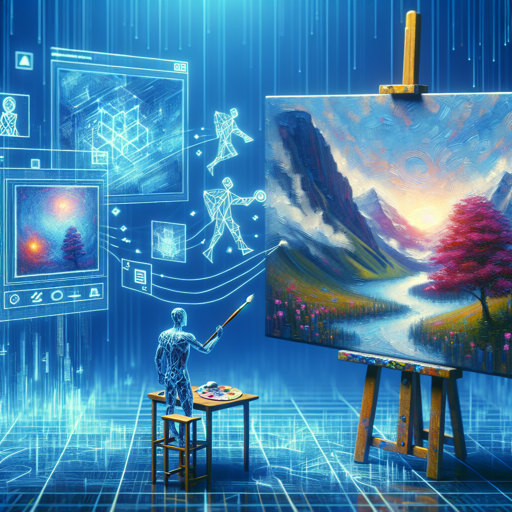Welcome to the exciting world of the LDM3D-SR model! In this guide, you will learn how to utilize this cutting-edge technology to generate stunning high-resolution images based on text prompts. Let’s dive into understanding and applying the Latent Diffusion Model for 3D (3D-SR) capabilities.
What is LDM3D-SR?
The LDM3D-SR model is part of a greater suite called LDM3D-VR, which specializes in creating and manipulating visual outputs for virtual reality applications. It employs advanced techniques to generate panoramic RGBD images and upscale low-resolution images to high-resolution outputs.
Imagine it like a digital artist who can not only paint breathtaking landscapes from descriptions but also transform tiny canvas artworks into breathtaking masterpieces, capturing every detail!
Getting Started
To begin, you’ll need to have a Python environment set up along with the necessary libraries. Below is a step-by-step guide to get you started:
Prerequisites
- Python (3.x version)
- Installation of the Diffusers library
- Basic knowledge of how to navigate Python packages and use pip
Installation
First, you will need to install the necessary libraries. Open your terminal and run:
pip install torch torchvision diffusersUsage Example
Now, let’s walk through the code to generate an image based on a text prompt and then upscale it.
from PIL import Image
import os
import torch
from diffusers import StableDiffusionLDM3DPipeline, DiffusionPipeline
# Generate a rgb-depth output from LDM3D
pipe_ldm3d = StableDiffusionLDM3DPipeline.from_pretrained("Intel/ldm3d-4c")
pipe_ldm3d.to("cuda")
prompt = "A picture of some lemons on a table"
output = pipe_ldm3d(prompt)
rgb_image, depth_image = output.rgb, output.depth
rgb_image[0].save("lemons_ldm3d_rgb.jpg")
depth_image[0].save("lemons_ldm3d_depth.png")
# Upscale the previous output to a resolution of (1024, 1024)
pipe_ldm3d_upscale = DiffusionPipeline.from_pretrained("Intel/ldm3d-sr", custom_pipeline="pipeline_stable_diffusion_upscale_ldm3d")
pipe_ldm3d_upscale.to("cuda")
low_res_img = Image.open("lemons_ldm3d_rgb.jpg").convert("RGB")
low_res_depth = Image.open("lemons_ldm3d_depth.png")
outputs = pipe_ldm3d_upscale(prompt="high quality high resolution UHD 4K image", rgb=low_res_img, depth=low_res_depth, num_inference_steps=50, target_res=[1024, 1024])
upscaled_rgb, upscaled_depth = outputs.rgb[0], outputs.depth[0]
upscaled_rgb.save("upscaled_lemons_rgb.png")
upscaled_depth.save("upscaled_lemons_depth.png")Code Breakdown
Let’s explore our code using the analogy of preparing a dish from a recipe:
- Ingredients: Here, we import necessary libraries like PIL for image handling and Torch for tensor manipulation, just like assembling all ingredients needed for your dish.
- Preparation: We create an instance of the LDM3D pipeline. This is akin to preheating your oven before cooking.
- Cooking: The pipeline processes our text prompt and generates images. Imagine that it’s like simmering your dish on low heat until all flavors meld together.
- Serving: Finally, we save our glorious creations. It’s like plating your dish for a beautiful presentation.
Troubleshooting
If you encounter any issues while using the LDM3D-SR model, here are some ideas to help you troubleshoot:
- CUDA Issues: If you experience memory errors or CUDA-related problems, consider running the model on a smaller input size or checking your hardware setup.
- Installation Problems: Ensure all required libraries are installed correctly and that your Python version is compatible. Running
pip freezecan help verify this. - Runtime Errors: Check your code for typos or misconfigured model parameters as they could disrupt the execution flow.
- For more insights, updates, or to collaborate on AI development projects, stay connected with fxis.ai.
Conclusion
Creating stunning visuals with the LDM3D-SR model opens new avenues in image generation. With these tools at your disposal, you have the power to bring your ideas to life! Utilize this model for imaginative projects and contribute to the vibrant field of AI and images.
At fxis.ai, we believe that such advancements are crucial for the future of AI, as they enable more comprehensive and effective solutions. Our team is continually exploring new methodologies to push the envelope in artificial intelligence, ensuring that our clients benefit from the latest technological innovations.

